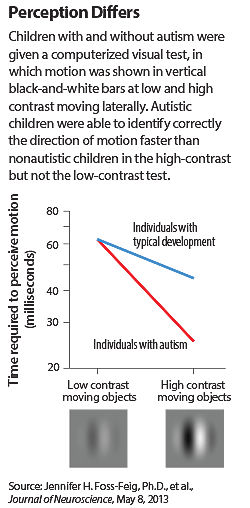Visual Perception Appears Heightened in Autism
Abstract
Children with autism have more heightened visual sensitivity to moving objects than peers without autism, which may point to their brain’s difficulty in filtering and controlling outside signals.
What is it like to see the world through the eyes of a person with autism? Patients’ subjective reports and brain research suggest it might be more chaotic and disturbing than a nonautistic person’s experience. Understanding the sensory dysfunctions could lead to better treatment of the disorder.
A recent study, published in the May 8 Journal of Neuroscience, reports an unexpected finding that children with autism have a sharper visual perception of moving objects than healthy peers do.
In a computer-assisted experiment, children and adolescents aged 8 to 17 with and without autistic spectrum disorder were asked to look at a circle on a screen against a gray background. In the circle were parallel vertical black and white bars that shifted from left to right or from right to left at varying speeds. Subjects pressed a button on the keyboard to indicate the direction of the movement as they saw it. The more they answered correctly, the faster the bars moved, until the child could not see the motions clearly and got it wrong. The autism test group was matched in age and IQ to the healthy subject group.
Besides varying the speed of motion, the researchers used a high-contrast moving image and low-contrast moving image in the test (see chart). As one would expect, a low-contrast image is more difficult to see than a high-contrast image. In the low-contrast test, both groups performed similarly, but when the moving image became sharper in the high-contrast test, the children with autism significantly outperformed the healthy ones. In other words, the autistic patients could perceive movement more clearly than healthy children under the high-contrast condition.

“We went into the study hoping to measure just the spatial suppression in autistic patients because this is an inhibitory mechanism, and autism is suspected to involve excitatory/inhibitory imbalance,” Duje Tadin, Ph.D., an assistant professor of Brain and Cognitive Sciences and Ophthalmology at the University of Rochester, one of the lead authors of the study, told Psychiatric News.
Spatial suppression refers to the somewhat counterintuitive phenomenon that when the size of a moving object is larger, the brain has more difficulty processing the image, Tadin explained. The brain suppresses visual perception of large moving objects because larger moving objects tend to be background motions and not very important in nature. The brain is better at recognizing smaller moving objects because they tend to be more important for humans to recognize clearly. Thus, the brain “blurs” large background moving objects through inhibition.
It has been theorized that the inhibitory function in patients with autism might be compromised. Although these researchers did observe some impairment in spatial suppression when both groups were tested with a low-contrast image, the results in the high-contrast test surprised them. The children with autism not only outperformed the healthy children but also showed a pattern of spatial suppression like the healthy children did. Tadin thinks that this observation can be explained by autistic children’s enhanced performance at the high-contrast condition that compensated for a small effect of spatial suppression.
Why do children with autism recognize movements faster than the peers without the disorder? The researchers believe it points to dysfunction in contrast saturation, which refers to the brain’s ability to cap the intensity of sensory stimuli at a certain level to prevent signal overload.
“It’s a braking mechanism of the brain that dampens high-intensity stimuli,” Tadin explained. “It’s like listening to radio. If the volume is too low, you can’t hear it, but if you turn it up too high, it hurts the ear. Your brain reaches a plateau at some point.” And, he noted, this study seems to suggest that the autistic brain had difficulty dampening the intensity of the visual stimulus by improving performance more than did the nonautistic brain when the test went from low to high contrast.
“Since we published this study, I got a lot of calls and e-mails from autistic patients who say that this overstimulation extends to other senses, like hearing,” he noted.
“We tend to consider autism as a social and behavioral disorder,” Tadin pointed out, but growing evidence supports an excitatory/inhibitory imbalance as a major neurological pathology. “When the stimuli are too strong, the lights are too bright, the sound is too loud, social situations can be disturbing.”
To further explore this theory, Tadin and colleagues plan to study possible impairments in other visual modalities such as brightness and color and other senses, as well as quantify the levels of contrast saturation. “The benefit of this visual test is that it’s easy to measure accurately and quantify differences in patients, while behavioral symptoms can’t be easily quantified,” Tadin said.
Potential clinical use of the findings may be far away, however, Tadin admitted, as the excitatory/inhibitory pathways in the brain involve various interconnected circuits. GABA and glutamate transmissions are suspected of playing a key role. ■
An abstract of “A Substantial and Unexpected Enhancement of Motion Perception in Autism” is posted at http://www.jneurosci.org/content/33/19/8243.abstract.



